
Canvas can draw many wonderful styles and beautiful effects. Through a few simple APIs, you can present ever-changing effects on the canvas. You can also create web games. Next, I will summarize the APIs related to drawing.
When painting, canvas is equivalent to the canvas, and context is equivalent to the brush.
1. Draw lines
moveTo(x0,y0): Move the current brush (ictx) to the position (x0,y0).
lineTo(x1,y1): Draw a straight line from the current position (x0, y0) to (x1, y1).
beginPath(): Open a path or reset the current path.
closePath(): Return to the starting point of the path from the current point, which is the position, avoidance and path of the previous beginPath.
stroke(): draw. This function must be added to draw the picture, so this must be placed at the end.
var icanvas=document.getElementById("iCanvas");
var ictx=icanvas.getContext("2d");
ictx.beginPath();
ictx.moveTo(0,0);
ictx.lineTo(300,150);
ictx.lineTo(3,150);
ictx.closePath();
ictx.stroke();
Effect: 
It should be noted here that if closepath is placed after the stroke function, it will not It will be drawn as a closed line, because it has been drawn before closing, so the straight line on the left will not be drawn.
2. Line style
lineCap: line endpoint style, butt, round, square. 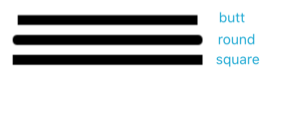
#lineJoin: The inflection point style when two lines intersect. When set to miter, you can also set the maximum length of the inflection point junction through miterLimet. 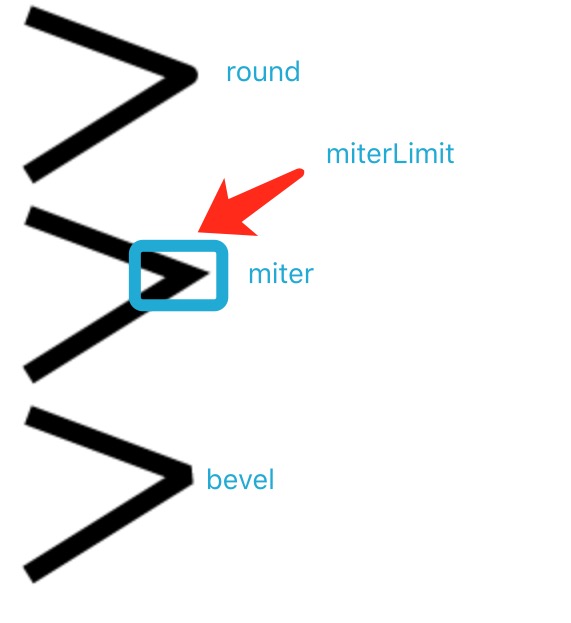
miterLimet: If the miter length exceeds the value of miterLimit, the corners will be displayed with the "bevel" type of lineJoin.
lineWidth: line width
strokeStyle: line color, gradient (defined gradient object), mode. context.strokeStyle="#333";
var iCanvas=document.getElementById("iCanvas");
var ictx=iCanvas.getContext("2d");
ictx.beginPath();
ictx.strokeStyle="#0000ff";
ictx.lineWidth=20;
ictx.lineCap="round";
ictx.moveTo(10,10);
ictx.lineTo(80,80);
ictx.stroke();
ictx.beginPath();//在这里必须beginPath,不然一直会以第一个为基础会话,在最后的stroke的时候,会再次画一条黑色的斜线,一共3条线。
ictx.strokeStyle="#000000";
ictx.lineCap="butt";
ictx.lineWidth=10;
ictx.moveTo(80,10);
ictx.lineTo(10,80);
ictx.stroke();
beginPath and closePath can appear unpaired. There is almost no relationship between the two. closePath is used to close the end point. Draw a closed path with the starting point.
3. Draw a curve
arc(x,y,radius,startAngle,endAngle,anticlockwise): draw a curve, radius is the radius of the curve, startAngle, endAngle starting angle and the end angle, using radians (Math.PI/180)*angle value, anticlockwise drawing direction;
arcTo(x1,y1,x2,y2,radius): Draw the curve before the two tangent lines.
ictx.beginPath(); ictx.moveTo(20,20); // 创建开始点 ictx.lineTo(100,20); // 创建水平线 ictx.arcTo(150,20,150,70,50); // 创建弧 ictx.lineTo(150,120); // 创建垂直线 ictx.stroke();
The starting point of the drawn curve and the end point of the horizontal line are tangent to the line connecting the first set point, and the end point of the curve and the first set point are tangent to The line connecting the second set point is tangent. 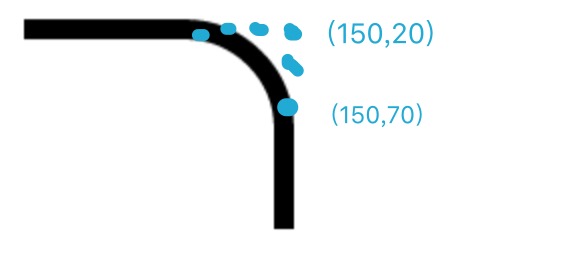
quadraticCurveTo(x1,y1,x2,y2): quadratic Bezier curve. (x1, y1) The coordinates of the control point, (x2, y2) the coordinates of the end point
bezierCurveTo(x1,y1,x2,y2,x,y): cubic Bezier curve. (x1, y1) The coordinates of control point 1, (x2, y2) The coordinates of control point 2 (x, y) The coordinates of the end point.
Bezier curves are very useful when drawing some very smooth curves.
4. Draw rectangle and fill
rect(): Create a rectangle;
fillRect(x,y,width,height): Draw the rectangle Filled rectangle: (x, y) starting point, width, height Rectangle width and height
strokeRect(): Draw a rectangular wireframe
clearRect(): Clear the rectangle.
ictx.fillStyle="#0000ff";//设定填充颜色 ictx.fillRect(20,20,150,100); ictx.strokeRect(180,20,100,100);
5. Brush attributes
fillStyle: Set the fill color, gradient or pattern (patten);
strokeStyle: Brush color, gradient or pattern
6. Draw shadow
shadowColor: Shadow yanse
shadowBlur: Blur level
shadowOffsetX: The horizontal distance of the shadow
shadowOffsetY: The vertical distance of the shadow
ictx.shadowBlur=20; ictx.shadowColor="#456"; ictx.shadowOffsetX=-10; ictx.shadowOffsetY=30;//先设置阴影再画矩形 ictx.fillStyle="#108997"; ictx.fillRect(20,20,100,80); ictx.stroke();
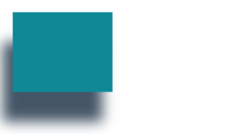
7. Draw gradient
createLinearGradient(x1,y1,x2,y2): Draw a linear gradient, (x1,y1) is the starting point of the gradient, (x2,y2) is Depending on the end point and position of the gradient, a vertical or horizontal gradient can be created.
createRadialGradient(x1,y1,r1,x2,y2,r2): Radial gradient: (x1,y1) is the starting point center of the gradient, r1 is the radius, (x2,y2) is the gradient End point, r2 is the end point radius;
Both gradients need to use
addColorStop(stop,color) to set the gradient process, stop is a value from 0.0 to 1.0.
var grd=ictx.createLinearGradient(0,0,170,0); grd.addColorStop(0,"#000"); grd.addColorStop(0.5,"#378923"); grd.addColorStop(1,"#ddd"); ictx.fillStyle=grd;//这里渐变是一个对象,用来向fillstyle传值 ictx.fillRect(20,20,150,100); var grd=ictx.createRadialGradient(300,225,15,250,225,100); grd.addColorStop(0,"#345"); grd.addColorStop(1,"#fff"); ictx.fillStyle=grd; ictx.fillRect(200,150,150,100);

8.填充背景
createPattern(image,"repeat|repeat-x|repeat-y|no-repeat"):image是一个图片对象,后面的参数是用来设定图片的重复方式。
9.其他相关API
fill():填充当前路径。
isPointInPath():ictx.isPointInPath(x,y);判断这个点是否位于当前路径
清除画布方法:获取画布的宽高,icanvas.height,icanvas.width;然后使用clearRect();
修改画布的宽高:icanvas.width='200';icanvas.width='300'的方法。
globalAlpha:设置透明度,只能是0~1的数字,如果透明度不一样,在画第二幅之前重新设置即可。
toDataURL:icanvas.toDataURL(type,encoderOptions),这个函数返回一个image的base64的URI,参数都是可选的,type可以设置图片类型如image/jpeg,image/webp,默认是image/png;encoderOptions是一个0~1的数字,用来设置image/jpeg,image/webp的图片质量,其他格式的type设置这个参数无效。
10.剪裁
clip():从画布中剪裁任意形状和尺寸的画布,之后所有的绘图都会被限制在剪裁的区域内。这个方法通常和绘制矩形,圆形等路径一起使用,在这些方法后面,剪切这个图像,后来画的就必须在这个剪切后的画布上了。
ictx.arc(100,100,50,(Math.PI/180)*0,(Math.PI/180)*360,true); ictx.stroke(); ictx.clip(); ictx.fillStyle="green"; ictx.fillRect(0,0,150,100);
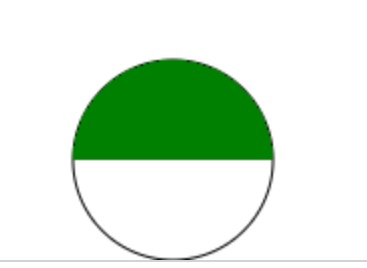
如果还想操作外部的画布,在剪切前使用save()函数保存,剪切后使用restore()函数恢复到之前保存的状态,但是中间做的操作不会消失哈。
以上就是详解html5 canvas常用api总结(二)--绘图API 的内容,更多相关内容请关注PHP中文网(www.php.cn)!




